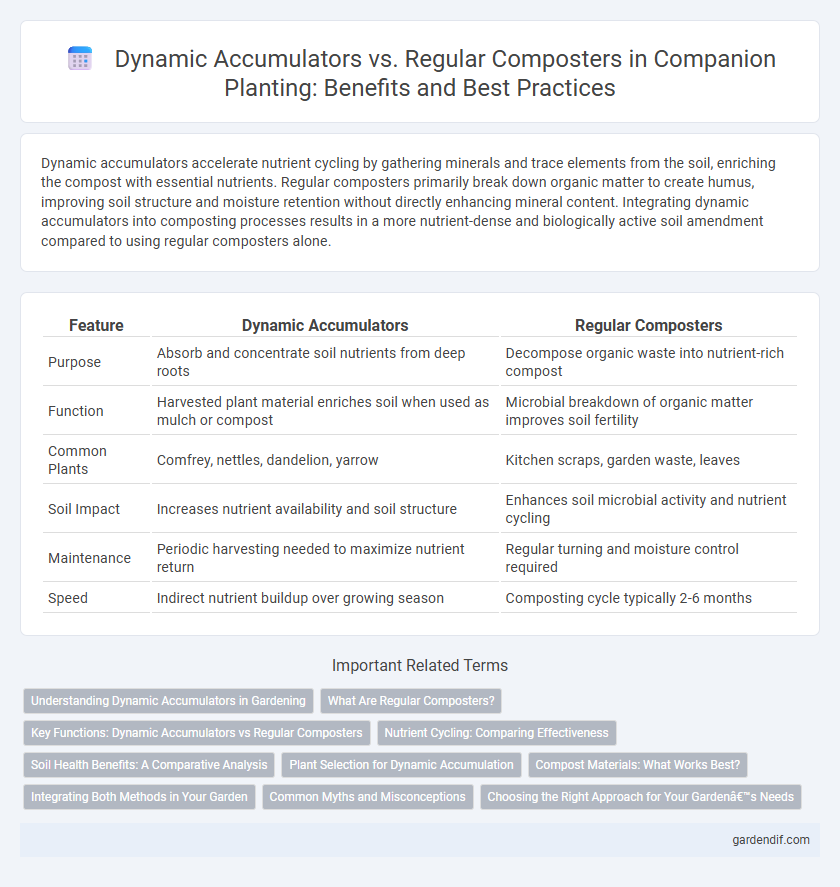
Dynamic accumulators vs regular composters Illustration
Dynamic accumulators accelerate nutrient cycling by gathering minerals and trace elements from the soil, enriching the compost with essential nutrients. Regular composters primarily break down organic matter to create humus, improving soil structure and moisture retention without directly enhancing mineral content. Integrating dynamic accumulators into composting processes results in a more nutrient-dense and biologically active soil amendment compared to using regular composters alone.
Table of Comparison
| Feature | Dynamic Accumulators | Regular Composters |
|---|---|---|
| Purpose | Absorb and concentrate soil nutrients from deep roots | Decompose organic waste into nutrient-rich compost |
| Function | Harvested plant material enriches soil when used as mulch or compost | Microbial breakdown of organic matter improves soil fertility |
| Common Plants | Comfrey, nettles, dandelion, yarrow | Kitchen scraps, garden waste, leaves |
| Soil Impact | Increases nutrient availability and soil structure | Enhances soil microbial activity and nutrient cycling |
| Maintenance | Periodic harvesting needed to maximize nutrient return | Regular turning and moisture control required |
| Speed | Indirect nutrient buildup over growing season | Composting cycle typically 2-6 months |
Understanding Dynamic Accumulators in Gardening
Dynamic accumulators are plants that absorb and concentrate essential nutrients like potassium, calcium, and nitrogen from the soil, making them valuable in organic gardening for soil enrichment. Unlike regular composters, which rely on decomposing organic matter to recycle nutrients, dynamic accumulators actively mine deep soil layers and store minerals in their leaves. Incorporating dynamic accumulator species such as comfrey, nettle, and dandelion helps improve soil fertility naturally and boosts plant health by providing targeted nutrient-rich mulch or compost ingredients.
What Are Regular Composters?
Regular composters are simple containers or piles designed to break down organic waste through natural decomposition, relying on microbial activity and aeration to produce nutrient-rich compost. These systems often require manual turning and monitoring of moisture levels to accelerate the composting process. Unlike dynamic accumulators, regular composters do not actively mine or concentrate specific nutrients from the soil but focus on recycling general organic materials into valuable garden compost.
Key Functions: Dynamic Accumulators vs Regular Composters
Dynamic accumulators actively extract and concentrate specific nutrients from the soil, enriching compost with targeted minerals like potassium, calcium, and magnesium. Regular composters primarily focus on decomposing organic matter to produce nutrient-rich humus, improving overall soil fertility and structure. Understanding these key functions enables gardeners to optimize soil health by combining dynamic accumulator plants with traditional composting methods.
Nutrient Cycling: Comparing Effectiveness
Dynamic accumulators enhance nutrient cycling by drawing specific minerals from deep soil layers and concentrating them in their biomass, which releases these nutrients more effectively when composted. Regular composters break down organic matter primarily through microbial activity, resulting in balanced nutrient release but often lacking the mineral enrichment that dynamic accumulators provide. Combining dynamic accumulators with traditional composting methods boosts overall nutrient availability and soil fertility in garden ecosystems.
Soil Health Benefits: A Comparative Analysis
Dynamic accumulators enhance soil health by actively mining nutrients from deep within the soil and making them accessible to plants, enriching soil organic matter and microbial activity more effectively than regular composters. While regular composters primarily recycle organic waste into nutrient-rich humus, dynamic accumulators contribute specific micronutrients and promote balanced soil pH, improving plant growth and resilience. Integrating dynamic accumulators with composting practices can optimize nutrient cycling and foster long-term soil fertility in sustainable gardening systems.
Plant Selection for Dynamic Accumulation
Dynamic accumulators selectively absorb and concentrate specific minerals and nutrients from the soil, making them ideal for targeted plant nutrition. Unlike regular composters that recycle organic matter into general soil enrichment, dynamic accumulators enhance soil fertility by integrating plants such as comfrey, nettle, and yarrow known for their high mineral content. Choosing dynamic accumulator plants strategically supports companion planting by improving nutrient availability and promoting healthier crop growth.
Compost Materials: What Works Best?
Dynamic accumulators, such as comfrey and nettle, concentrate vital nutrients like nitrogen, potassium, and calcium, enriching compost materials faster than regular composters. Incorporating these plants into compost piles enhances the breakdown of organic matter, leading to nutrient-rich compost ideal for gardens. Regular composters benefit from diverse green and brown materials but lack the targeted nutrient boost provided by dynamic accumulators.
Integrating Both Methods in Your Garden
Integrating dynamic accumulators and regular composters in your garden enhances soil fertility by combining nutrient-rich plant deposits with decomposed organic matter. Dynamic accumulators, such as comfrey and nettle, draw up minerals deep in the soil, while regular composters break down kitchen scraps and garden waste into humus. Utilizing both methods optimizes nutrient cycling, supports microbial activity, and promotes healthy plant growth.
Common Myths and Misconceptions
Dynamic accumulators are often mistakenly believed to absorb and store nutrients in their leaves, which can then be released directly into compost or soil; however, they primarily improve soil health by enhancing microbial activity rather than serving as nutrient tanks. Regular composters are commonly thought to decompose organic matter quickly regardless of maintenance, but effective composting requires proper aeration, moisture control, and balanced carbon-to-nitrogen ratios. Misconceptions about both methods overlook the crucial roles of microbial ecosystems and nutrient cycling in achieving sustainable soil enrichment.
Choosing the Right Approach for Your Garden’s Needs
Dynamic accumulators enhance soil fertility by drawing up and storing nutrients in their leaves, making them ideal for nutrient-poor gardens seeking natural enrichment. Regular composters recycle organic waste into nutrient-rich humus, providing a balanced, consistent source of nutrients and improving soil structure. Selecting between dynamic accumulators and regular composters depends on your garden's existing soil quality, nutrient demands, and maintenance preferences.
Dynamic accumulators vs regular composters Infographic

 gardendif.com
gardendif.com